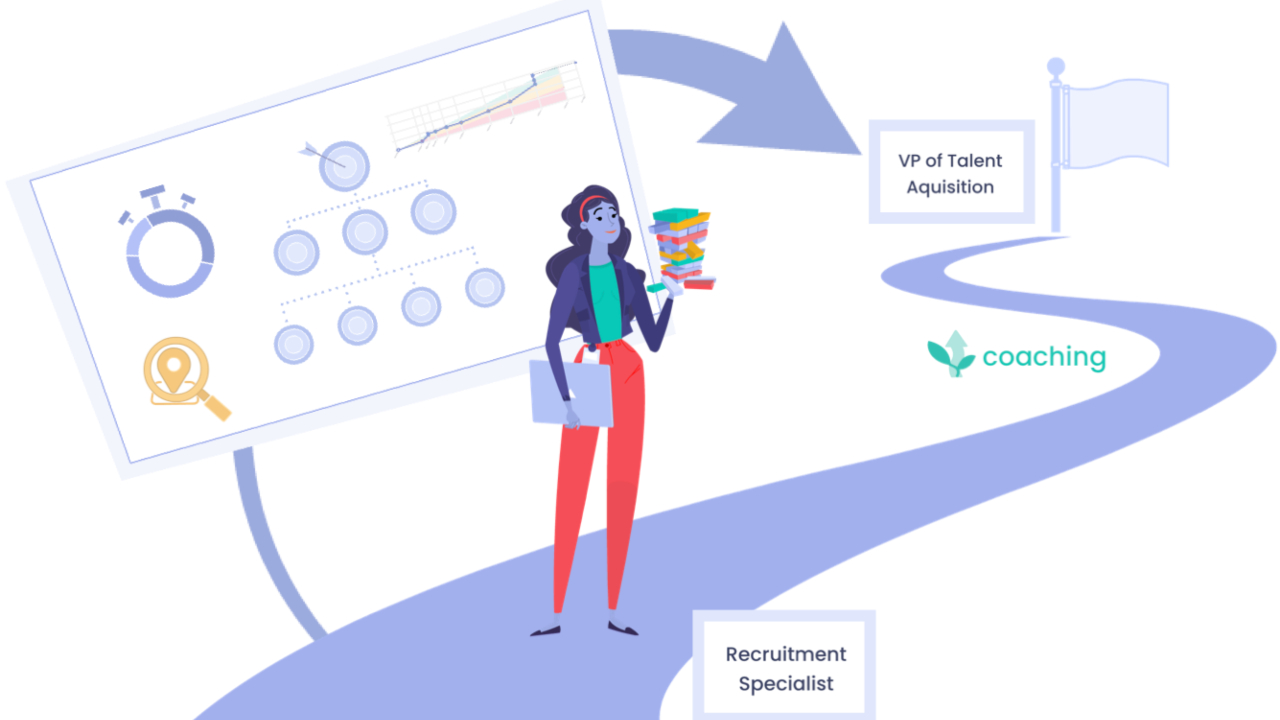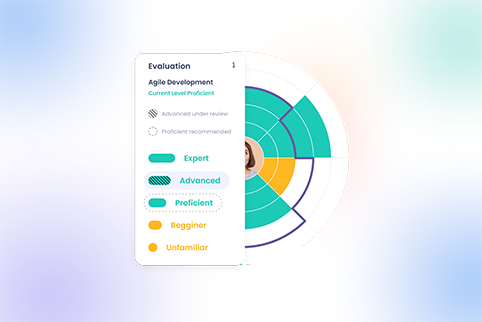Career Pathing: HR’s Secret to Attracting and Retaining Top Talent
10 min read

Low employee engagement levels and high turnover rates are some of the most pressing challenges for employers and HR departments. And they aren’t limited to one area or industry. 93% of organizations are concerned about employee retention, according to LinkedIn’s Workplace Learning Report. And this is where career pathing comes in!
But what is career pathing? Career pathing plans facilitate employee growth and ensure both stability and agility for businesses in the long run. If implemented correctly, it can address many pain points expressed by employees, from lack of fulfillment to feeling like a cog in the corporate machine.
In this article, we look at the definition and importance of career pathing, why it has become so important, and how to actually design an effective step-by-step career pathing plan.
What is career pathing?
Career pathing is the strategic process of planning in detail how an employee can move from the current position to their ultimate career goal within your organization. It involves setting specific development goals, acquiring relevant skills, gaining experience, and identifying potential opportunities for advancement or career changes.
You can regard the entire process as a roadmap through which employees can envision their future in the organization and visualize different potential trajectories they might pursue ahead.
While career paths are often linear or focused on vertical moves, lateral transitions can also be part of the planning process — either from the start or along the way — and, of course, lateral moves can lead to vertical moves as well. Or, in other words:
Unlike the traditional career ladder, career pathing is a flexible process and presents employees with multiple paths toward growth and career progression.
Although it is mainly the responsibility of HR, career pathing can become a more seamless and hassle-free process with insights from managers and team leaders, who have a better understanding of the potential and limitations of their people.
Why is career pathing important?
Organizations should take career pathing seriously because it is directly related to employee engagement and satisfaction — both factors that determine to a large extent the ability to attract and retain top talent and especially young workers.
When people feel or see that they can no longer grow with their current employer, or that their skills aren’t used to the full extent, they won’t hesitate to look for opportunities elsewhere. This is backed by LinkedIn data revealing that:
Opportunities for career growth within the company and opportunities to learn and develop new skills are among the top 5 factors that people consider when pursuing new jobs.
Other benefits of having a career pathing plan in place include:
- Higher motivation and morale: Giving people something to aim at keeps them motivated and involved. It prevents the feeling of stagnation and creates excitement about future possibilities. This is mainly driven by dopamine, or the feel-good chemical, which is released when we make progress toward goals.
- Improved productivity: Engaged employees who strive to perform at their best naturally produce the best products/services and business outcomes. The opposite is also true: disengaged employees can make mistakes, which will affect the company’s relationship with partners or customers.
- Boosted internal recruiting: When implemented well, career pathing can improve the efficiency of recruiting initiatives by filling open positions with internal candidates. Identifying and evaluating people with the right potential will be faster and the company will be in a better position to deal with unforeseen retirements or departures. It also reduces the higher costs associated with external recruiting.
- Streamlined succession planning: Well-planned career paths and having a pipeline of top performers will prevent (potential) gaps in leadership skills and the loss of highly-specialized knowledge when vital people decide to move to other challenges.
How to develop a career pathing plan in 8 steps
Although the advantages of career pathing are clear and undisputable, there are several steps you need to take to get started with developing effective career paths for your employees:
1. Determine your business needs and goals
Career pathing needs to be in alignment with the company’s strategic goals. At this point, questions like “What it takes to stay competitive in the next 5 years?”, “How can I incorporate new technologies in day-to-day activities to reduce redundant activities?”, or “Does it makes sense to extend my line of business into new areas?” may arise.
Talent strategies should be closely related to these goals and support people to adapt and pivot alongside their organization’s needs. Therefore, employee career paths should be designed to address those needs.
The most common ones may include:
- Developing future critical skills: Help current employees to develop new skills and competencies that are critical for business needs in the short and long term.
- Ensuring a solid pipeline of candidates for Succession Planning: Identify key positions within the organization and create career paths that include succession planning to reduce the risk of leadership gaps.
- Boosting Diversity and Inclusion initiatives: Encourage and support employees from diverse backgrounds to progress and reach leadership positions within the organization.
- Reducing employee turnover: Develop and implement comprehensive career path frameworks that clearly outline growth opportunities within the organization. This will encourage employees to stay with the company, increase engagement, and reduce turnover.
Therefore, these goals, as well as the requirements and skills needed to reach them should be established from the start.
2. Map out an organizational structure
Helping employees visualize multiple career paths they can pursue inside the company starts with a solid understanding of how hierarchy, advancement and development work at your company.
This is why the first thing you should do is to update the structure of your organization (or create one, if needed) and ensure it is aligned with short- and long-term business goals. It will help employees understand the growth opportunities available within the organization and provide them with a clear path for career advancement.
The next step is to clearly define every job role — including responsibilities, (hard and soft) skills, experience, as well the performance expected from candidates taking on the role. During this process, it’s just as important to highlight the skills that are transferable from one job to another.
Once established, these business needs and goals can serve as a basis for better job descriptions and recruiting materials — for both internal and external candidates. For example, one important aspect should be separating the core or essential skills of a role from the desirable or nice-to-have skills, which can be developed later.
3. Understand the aspirations and career goals of your people
The next step is having one-on-one conversations with each employee to discover their short- and long-term plans, as well as potential blockers or worries that might prevent them from advancing in their career.
But what about those who aren’t sure what career path to follow?
You can help them gain more clarity by identifying different tasks or projects that they are willing to try out and, in time, select the ones that resonate with them while still being aligned with organizational objectives.
These talks will also serve as the foundation for personalized employee development plans (which we’ll explore in another section below), highlighting the strengths, compatibility, and also key areas where improvement needs to happen to make the next step in their career path.
4. Develop personalized career paths for every employee
One aspect of personalized or tailored career paths is flexibility. This involves understanding that not all employees want to have a linear or vertical progression and that not everyone who goes through development or leadership programs will succeed.
Another aspect, related to the first one, is having a roadmap in place for skills and proficiency levels. Or, in other words, defining the (multiple) ways entry-level employees can use to advance to different roles. This process should also take into account different personality types (e.g., extrovert vs introvert) and the fact that the path to some management roles can initially involve a series of lateral moves.
While finding as many opportunities as possible that align people’s aspirations with organizational needs is the goal, regular discussions should take place to check whether the initial aspirations have changed or perhaps a different career path has caught the interest of a particular employee.
5. Create an employee development plan
While career paths represent the entire journey of a person, from entry-level to managerial or leadership positions, employee development plans are the connections or what gets them from one stage of their career to the next.
You can see career paths as the zoomed-out perspective and development plans as the actions, challenges, and adjustments made to ensure the smooth progression from one role to another.
These actions and challenges will vary significantly from one employee to another. For those interested in vertical moves, upskilling programs, and mentorship will make more sense. For lateral moves, it’s all about reskilling and the ability to learn, unlearn, and relearn different abilities.
In either case, learning and development opportunities should be transparent and easily accessible to everyone, so that no member of your workforce feels limited in their choices regarding career progression. This is also one of the best practices associated with non-linear career paths.
6. Track employee performance and progress
Once career paths are defined and actions for development plans are underway, the next stage is to monitor the progress of every worker.
This should happen through regular check-ins and feedback sessions, where one of the main goals is clarifying whether the current growth opportunities are working or maybe other ones should be given a try.
Along the way, some employees could realize they no longer want to go in the initially established direction. In that situation, the process needs to restart by identifying a new career path and designing an effective growth plan. Again, it’s all about being flexible and embracing open communication.
7. Reward and praise professional development
Both small and big achievements should be celebrated because this keeps your workforce motivated and inspired. Of course, it also makes high achievers feel appreciated and their efforts valued.
Public displays in this direction are relevant because they serve as an example for other peers that dedication and involvement pay off and the organization is serious about the success of its people.
In time, rewards and compensations for professional development will help nurture a culture where lifelong learning and growth are the default way of looking at work and career progression.
8. Evaluate your career pathing process on an ongoing basis
At regular intervals, you should ask for feedback from people who successfully transition to the next stage of their careers. And, perhaps even more importantly, also listen to feedback from the ones who fail to do so.
Seeking to understand why will inevitably lead to the betterment of your career pathing process. The goal is to discover which steps, initiatives, and L&D opportunities are the most effective and to double down on them.
Keep your eyes open for new tools and approaches that will ensure your career pathing process is not only successful now, but also in the future. For instance, talent marketplaces are a powerful solution to align internal candidates with developments and internal mobility opportunities available in your organization.
Final thoughts
While not new, career pathing is turning out to be a vital way for HR professionals and business leaders to help employees develop their skills and grow inside the company. By making it a priority, organizations demonstrate genuine interest and investment in their workforce, leading to higher retention and attraction of top talent.
As a direct result, both employers and employees will enjoy long-term success as well as fulfillment and the peace of mind that comes with becoming more flexible and adaptable.







